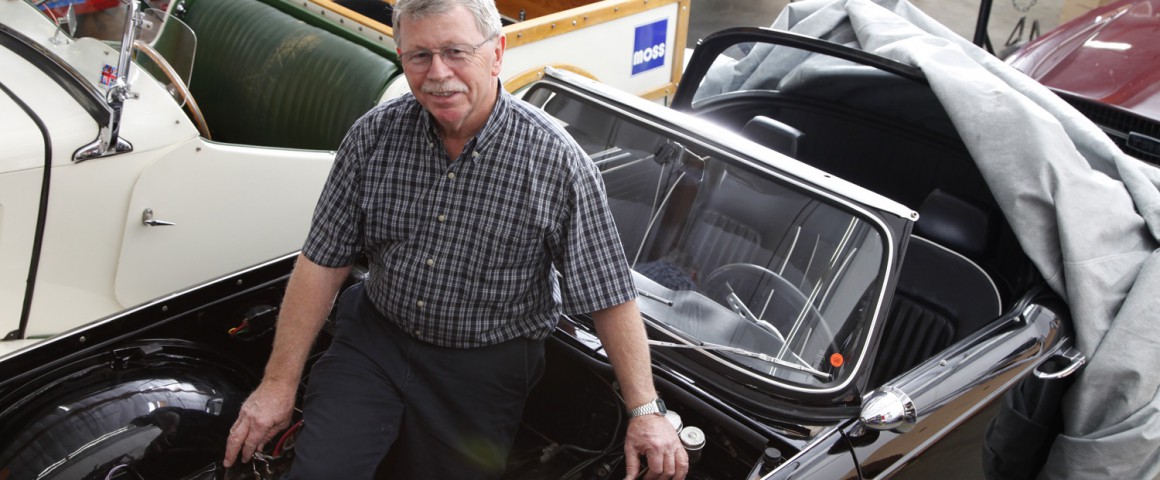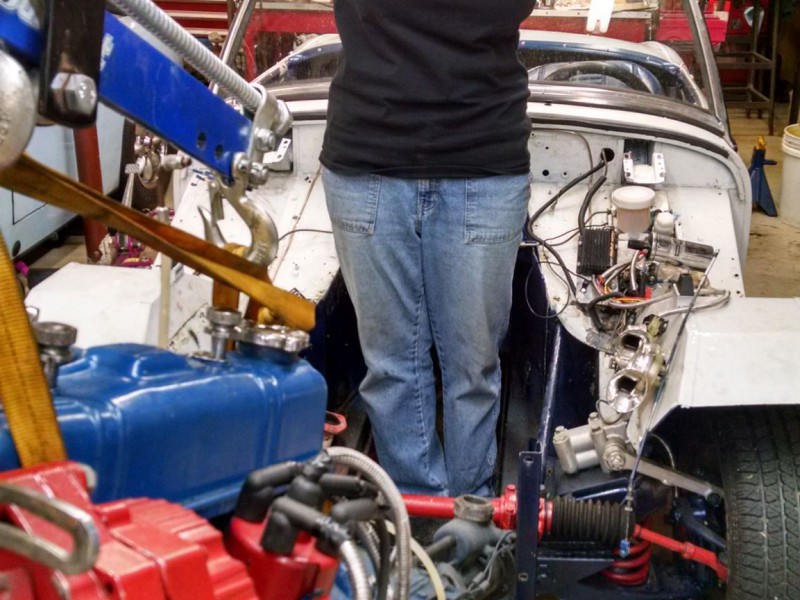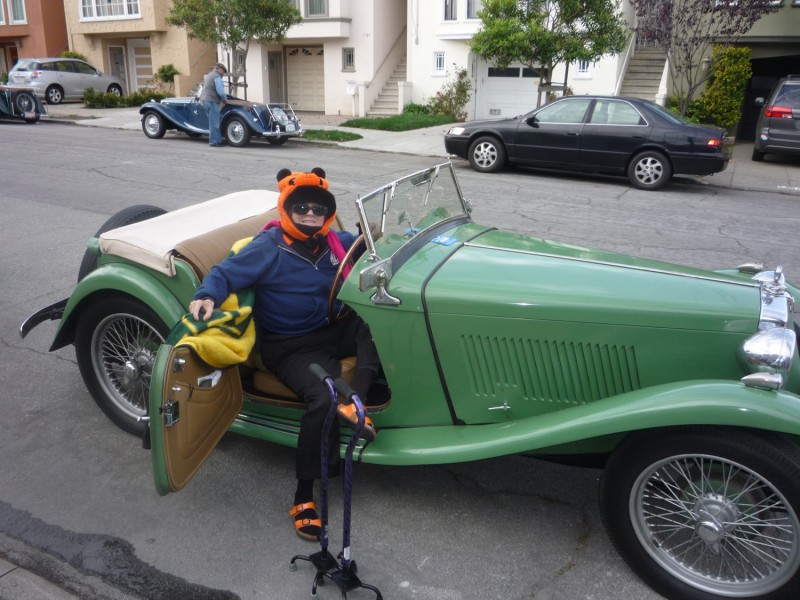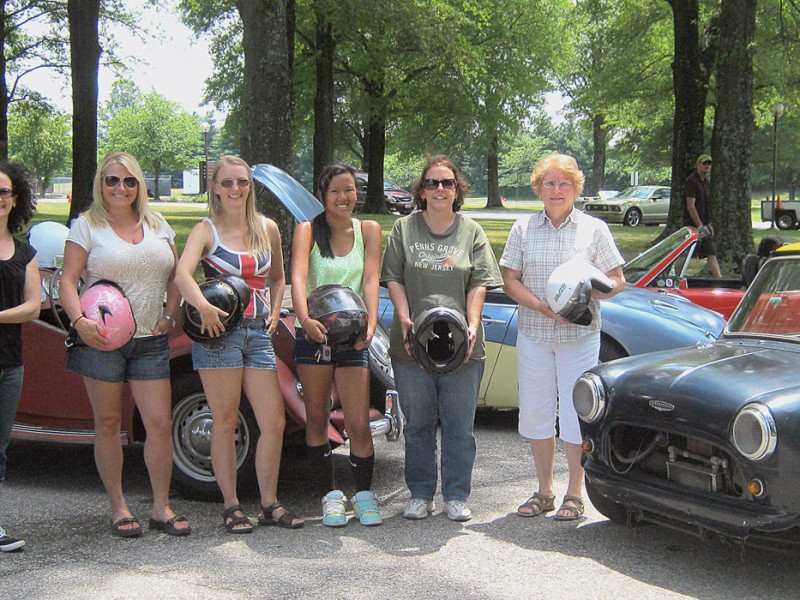Long, long before working in the Technical Support department at Moss Motors, I was a “dopey kid from Kiwitahi” who traveled to England and started knocking on the doors of race shops. I do not think that would work today.
A love of motorsport runs strong in my family and in the whole of New Zealand, where I was raised. Racing, and the people I met through the sport, are an important part of what defines me.
I do have to admit that I have quite a bit of “stuff” out in the garage. My dear wife Judy did intend to tidy it up one day, but when she opened a cupboard to rearrange things she was almost killed by the pile of Road & Track and MotorSport magazines and books that spilled out. She has never dared to go back! Among the stuff I found photos and race programs that brought back memories. I was asked if I’d share them…
Dad had stopped the shearing and we were glued to the radio. Bruce McLaren was in the lead of the 1961 New Zealand Grand Prix! But it was not to last, as Jack Brabham passed him and held him off for a close finish. These are important times with my father, as he did not live much longer. He died way too young.
The first race I ever attended was the 1959 New Zealand Grand Prix at Ardmore. I have faint memories of the noise and smell of racing fuel, and waiting in long traffic lines, especially when leaving. It was a hot day and I do remember seeing for the first time a young woman in a leopard-skin bikini walking by and my dad clipping me on the ear and telling me to concentrate on the racing. It was all a bit much for a young fella from Kiwitahi. I also remember seeing Stirling Moss sitting up in his Cooper and steering with his feet and waving to the crowd on the last lap as he was so far ahead of Jack Brabham.
NZGP – January 6, 1962 – Ardmore’s last GP
By two o’clock, as the main event was to begin, it really started to rain, and by this time we were pretty well drenched. It was amazing the race was allowed to start, and we thought the weather would clear, but it only got worse. Stirling Moss did not have time to qualify and had to start at the back of the 21-car field. I still have the clipping showing his position at College Corner on the very first lap—in 7th place! Unbelievable! After one of his greatest drives, Stirling beat everyone in dreadful conditions. It was also one of his last wins before a crash at Goodwood this same year ended his main racing career.
NZGP – January 5, 1963 – Pukekohe
We got up early to pile into our 1960 Humber Hawk. With dad at the wheel plus an uncle and the rest of us little urchins piled in the back on a hot summer day, we headed off to Pukekohe. Uncle George told us how he was camped there before being shipped off to North Africa in WWII. We arrived and parked over by the Loop Corner, which was after the Elbow. You have to search through the archives to find those corners now. We just stayed at the car and watched the racing. At the start of the Grand Prix I noticed how bright and shiny were the wheels on Bruce McLaren’s Cooper. We were disappointed when he dropped out, and then we cheered on Graham Hill in the Ferguson because we had a Fergie tractor at home. Graham’s car came to a halt on the last lap and Angus Hyslop came in second to John Surtees in a Lola. I think we were all disappointed in how the day turned out and it was a long haul home.
Surtees and his Lola had made it look too easy. It was not until years later when I was at Laguna Seca in 2007 and I met up with Peter Bryant that I found out more about the details of the race. When I mentioned to him that I was from New Zealand he began to tell me what he remembered of being a mechanic for John Surtees’ Lola 2.7 Liter. All cars were run on methanol fuel and so they had taken their wet sleeve cylinder liners to be treated with a graphite process which helped avoid the engine oil being washed off the cylinder walls, causing less engine wear. They kept the process secret. They also used dry ice around the fuel tanks on hot days, which had the dual effect of having the engine run cooler and produce more power and also kept the cockpit cooler. The Lola certainly ran well that day in 1963 and easily won the Grand Prix.
NZGP – January 7, 1967
I remember piling into a Mini and heading to Pukekohe with some friends. My sister said we looked like a bunch of monkeys as we sped past her and her policeman husband. Whoops! We spent most of the day on the infield enjoying the battle for the lead between Jackie Stewart in his BRM P261 and Jim Clark in his Lotus 33. Clark’s Lotus came around on the last laps with the nose missing from a collision with a slower car. Good memories. I got in close at the prize-giving ceremony with my Brownie camera and even though the quality is no good, it does show Jackie Stewart with short hair and the winner’s trophy.
A Foot in the Door
I arrived in London in September of 1972 and watched all my New Zealand friends move on to travel around the Continent. I stayed, as I wanted to try to get into a motor racing team. I went north at the first weekend to a Formula Two meet at Oulton Park, near Chester. I went very early by train expecting it to be crowded at the track. Compared to New Zealand events the attendance was sparse, especially as the field consisted of Niki Lauda, Ronnie Peterson, James Hunt, John Surtees, Graham Hill, Tim Schenken and Jody Scheckter. I wandered about the paddock area chatting to different people and teams. The only team that showed any interest in me that day was the Team McLaren. Their M21 F2 car was beautifully prepared and easily led the race until retiring with a failed clutch.
September 18, 1972
I took the bus from Earls Court out to the London Airport area and finally ended up at Colnbrook and started looking for McLaren Racing thinking that after all its success it would be a large place (like it is today), but it was just a plain structure. The woman at the desk was friendly and I was introduced to Don Beresford, the shop manager. He showed me around, including the construction of the first M23. I managed to ask some desperate questions about side radiators versus the front intake. I think he was about to show me out when I pulled out some racing artwork that I had done which seemed to get his attention. He said, “You must be keen if you have come this far.” So he called Bill Meace at Trojan Works to see if he had any openings. Don kindly loaned me a Hewland Transmission workshop manual and told me to read it before I went to the interview. I appreciated that, as I had not touched a Hewland gearbox before. I had two days to study.
I took the train to Croydon and went to the Trojan Works headquarters at Kingsley House for my interview. I had studied the Hewland manual and felt prepared. Bill Meace showed me all the different Trojan enterprises, from the vintage restorations to the motorbikes for the Suzuki of Great Britain division, the Hewland gearbox division, and finally onto the Trojan Racing workshop, a short distance away on Beddington Farm road. I was completely enthralled with it all. Bill took me to lunch and was recalling Bruce McLaren and the day he learned Bruce had died and what it all meant to the Trojan Company. So after lunch, and not being asked any Hewland questions, I finally asked if I had a job, and he said I did because when I spoke it reminded him of Bruce. So that is how I came to be the only Kiwi working at Trojan. I was to start in ten days on October 1st.
During those ten days I met Judy, my dear wife to be, who was from California and traveling on her own. I used to hang around the American Express office in Trafalgar Square. I met American girls who could not understand English guys, thought Australians were too loud, and South Africans were too quiet. Kiwi guys were just right!
October 1, 1972
I went to the Trojan Racing workshop on my first day working there. The M21 F2 racecar that Jody Scheckter had driven at Oulton Park a few weeks prior was in the midst of being dismantled so as to form the basis of a new F5000 car. The main body/tub was a McLaren M22 and the suspension and steering was from the M21.
If only I had money at the time. Around Trojan there were all sorts of tubs, panels, wheels and engines I could have bought. But at 38 pounds a week it was tough to even buy tires for my Morris Minor. As our gearbox department was about half a mile from the race shop, the Morrie was like a shuttle to pile into for lunch at the cafeteria. There were always interesting people in there with lots of stories. I enjoyed the conversations of older craftsmen who lived in Croydon during the war and their stories of German V-1 bomber strikes. Many bombs were dropped on Croydon just so the Luftwaffe could save weight and make it back to Germany. Many drivers such as Denis Hulme, Jody Scheckter and Barry Sheene would also come and sit at the tables. I remember a Scottish driver, Gerry Birrell, lunching with us on a Tuesday and on Saturday he was killed in a Formula Two race in Rouen, France.
I was surprised at how few of the Trojan staff went to races. To me, building a racecar was more than just a job. I went to as many races as I could. Being with Hewland, who supplied most of the teams with gearboxes, I could get in and hang out with the winners!

March’s Robin Herd talking to Jean-Pierre Jarier. Patrick Head is taking a look at the rear area of the car. The Trojan team was about to expand into the world of Formula One for the 1974 season and Patrick was always interested in what the other teams were doing. Can you imagine walking up to another team’s car today and peering in and checking it out without being thrown out?

The author on the left, about to load up the mighty powerful but very unreliable M8F Turbo. Teddy Pilette was a brave driver who said that “When driving this car on a fast corner it always felt like the back is going to overtake the front, while at the end of the straight the brakes have to stop almost a ton traveling at 170 MPH.” A brave driver indeed while trying to control 1300 BPH!

Keith Holland entering Goodwood past a concerned looking Patrick Head. The Trojan T102 ran okay and did show promise before having fuel pump problems.
November 9, 1973 – Goodwood Motor Circuit
When we first arrived we had to wait while the March Formula One team was testing their 731 car. It was great to watch J.P. Jarier powering his way around the old chicane area. This was before the days of wind tunnels and so masking tape was used in various ways.
As we drove back to London after the race, all the news was about the upcoming Arab oil embargo as a result of the Arab-Israeli war in the Middle East. This was about to have a big effect on all motor racing and changes were coming.
I was soon on my way to California, and I jokingly note that Trojan never won again after I left. These and many other stories I’ve shared on the vintage racing forum at www.theroaringseason.com.
Looking back, the experience of being around cars and competition all my life has been invaluable. Certainly it helps when assisting customers with their many varied questions. But more than that, being a part of this community has had a profound impact on my life.
By Ken Hyndman












'Moss Profile: Ken Hyndman' have 2 comments
April 27, 2016 @ 3:28 pm Mick Kerr
Hi Ken, remember me?
I am Mick Kerr and I was Keith Holland’s mechanic on the Trojan F5000 cars.
I just found this story and your thread on The Roaring Season whilst looking for pictures from my past for my daughter.
Brought back lots of good memories.
Cheers. Mick.
August 28, 2017 @ 12:32 pm Chad R.
What a great story. I’ve known Ken from the races, but this additional insight into his early exposure to motorsport was a treat to read.